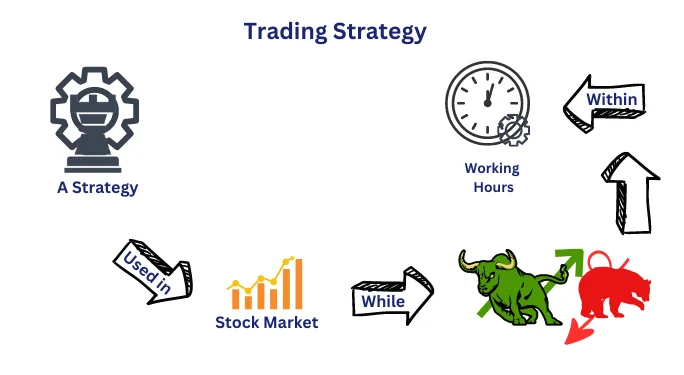Stocks are a crucial component of accumulating wealth over the long term, according to any financial expert. But the challenge with stocks is that while their value can increase exponentially over time, it is impossible to accurately forecast their day-to-day movement.
Which begs the question: How can you make money in stocks?
Actually, as long as you follow some tried-and-true methods and exercise patience, it’s not that difficult.

1. Buy and Hold
Long-term investors often use the adage “Time in the market beats timing the market.”
Why does that matter? In short, a buy-and-hold strategy, in which you hold stocks or other securities for a long time rather than frequently buying and selling (also known as trading), is a common way to make money in stocks.
This is crucial because investors who frequently enter and exit the market on a daily, weekly, or monthly basis frequently miss out on chances to earn significant annual returns. You don’t think so?
Think about this According to Putnam Investments, those who stayed fully invested in the stock market for the 15 years up until 2017 received an annual return of 9.9%. However, if you frequently entered and exited the market, your chances of seeing those returns were jeopardized.
- The annual return was only 5% for investors who missed just 10 of the best days during that time period.
- For investors who missed the 20 best days, the annual return was just 2%.
- In reality, missing the 30 best days led to an average yearly loss of -0.4%.
It is obvious that missing out on the market’s peaks will result in significantly lower returns. Even though it might seem like the best course of action is to simply make sure you’re invested on those days every time, it’s impossible to know when they will occur, and occasionally days of excellent performance are followed by days with significant drops.
To ensure you take advantage of the stock market at its peak, you must commit to a long-term investment strategy. Using a buy and hold strategy can assist you in achieving this objective. (Plus, it benefits you financially come tax time by lowering your capital gains taxes.)
2. Opt for Funds Over Individual Stocks
Experienced investors understand that diversification, a tried-and-true investing strategy, is essential to lowering risk and potentially increasing returns over time. Consider it the equivalent of not putting all of your eggs in one basket when investing.
The majority of investors favor either individual stocks or stock funds, such as mutual funds or exchange-traded funds (ETFs), as investments, but experts typically advise the latter to maximize diversification.
While you can purchase a variety of individual stocks to mimic the automatic diversification found in funds, doing so can be time-consuming, require a fair amount of investing knowledge, and require a sizable cash commitment. For instance, a single share of one stock may cost hundreds of dollars.
Contrarily, funds enable you to purchase exposure to hundreds (or thousands) of distinct investments with just one share. While everyone wants to invest their entire portfolio in the next Apple (AAPL) or Tesla (TSLA), the truth is that most investors, including professionals, have a poor track record of identifying businesses that will generate exceptional returns.
Because of this, experts advise the majority of investors to invest in funds that passively follow important indices, such as the NSE Nifty or BSE Sensex. This puts you in a position to profit as easily (and inexpensively) as possible from the stock market’s approximate 10% average annual returns
3. Reinvest Your Dividends
A dividend is a regular payment made to shareholders by many companies that is based on their profits.
Even though the dividend payments you receive may seem insignificant, especially when you first begin investing, they have historically contributed significantly to the growth of the stock market. Since its inception, the Nifty 50 has returned about 12%, but when dividends were reinvested, the percentage increased to almost 16%. Because each dividend you reinvest allows you to purchase more shares, your earnings compound even more quickly.
Many financial advisors advise long-term investors to reinvest their dividends rather than spending them as soon as they are received due to the enhanced compounding. The majority of brokerage firms give you the choice to enroll in a dividend reinvestment program, or DRIP, in order to automatically reinvest your dividend.
4. Choose the Right Investment Account
The account you decide to keep your investments in is just as important to your long-term investing success as the specific investments you choose.
That’s because some investment accounts, like the National Pension Scheme (NPS), let you benefit from specific tax advantages. While the money is kept in the account, you can avoid paying taxes on any gains or income you may receive. As you can postpone paying taxes for many years on these positive returns, this can significantly boost your retirement savings.
Each subscriber may have a maximum of one NPS account, with a minimum opening deposit of INR 500.
NPS Tier I is a tax-free investment that is free of taxes throughout the entire investment and return process. Taxes are not applied to the amount invested, the interest earned on it, or the total amount withdrawn at the conclusion of the program. After the age of 60, one may withdraw up to 60% of their total investment. This 60% investment is going to be regarded as tax-free.
Of course, there are some situations that permit you to access that money early penalty-free, such as dealing with exorbitant medical expenses or the economic effects of the COVID-19 pandemic. However, once you’ve placed your money in a tax-advantaged retirement account, the general rule of thumb is that you shouldn’t touch it until you’re of retirement age.
Simple taxable investment accounts, on the other hand, don’t provide the same tax benefits but do allow you to withdraw your money whenever you want for any purpose. By selling your losing stocks for a loss and receiving a tax break on some of your gains, certain strategies, such as tax-loss harvesting, are now possible for you to use.
All of this means that in order to maximize your returns, you must invest in the “right” account. Investments that typically lose less of their returns to taxes or money that you will need in the coming years or decades may be best kept in taxable accounts. On the other hand, tax-advantaged accounts may be a better fit for investments that have a higher chance of losing more of their returns to taxes or those that you intend to hold for a very long time.
Both types of investment accounts are offered by the majority of brokerages (though not all), so confirm that your preferred firm offers the account type you require. Check out Forbes Advisor’s ranking of the top brokerages if yours doesn’t or if you’re just beginning your investing journey to make the best decision for you.
the conclusion
You don’t have to spend your days speculating on which specific companies’ stocks might rise or fall in the near future if you want to succeed in the stock market. In fact, even the most successful investors, like Warren Buffett, advise people to put their money in inexpensive index funds and hold onto them for years or decades until they need it .Consequently, the tried-and-true secret to wise investing is unluckily a little dull. Instead of chasing the newest hot stock, just have patience that diversified investments like index funds will pay off in the long run.
FOR MORE INFO CLICK THIS SITE:https://learningsharks.in/
FOLLOW OUR PAGE:https://www.instagram.com/learningsharks/?hl=en















